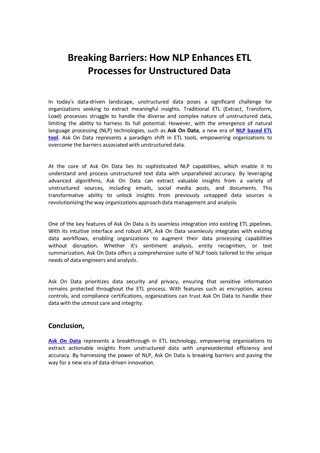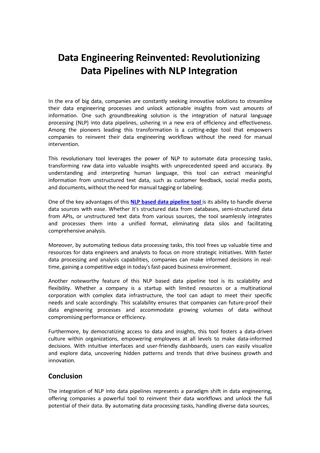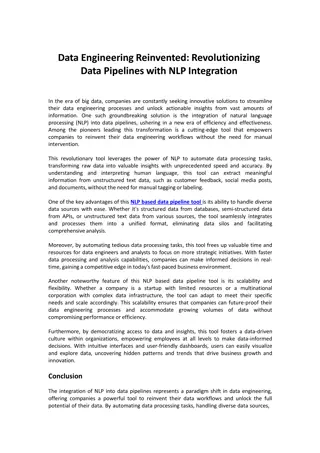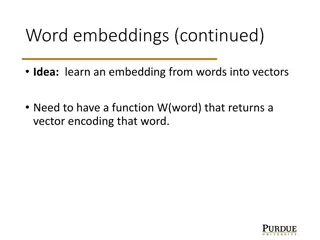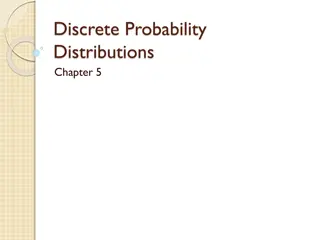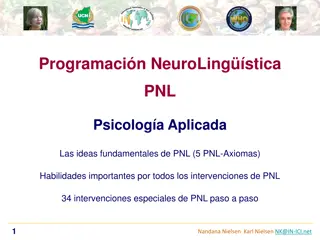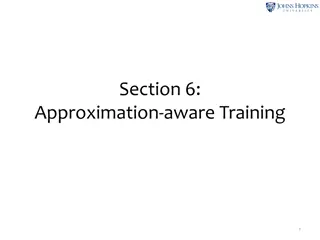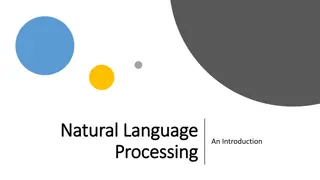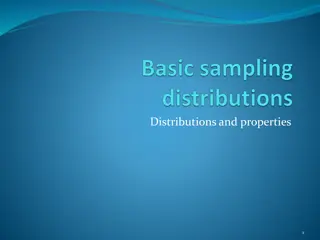Overview of NLP Word Distributions and Stop Words
Introduction to NLP discusses how words are not evenly distributed using examples like the 80/20 rule. The distribution of words in Shakespeare's "Romeo and Juliet" is highlighted, showing common word frequencies. Additionally, Stop Words Fact explains how common English words dominate text composition with examples from Moby Dick. These insights shed light on language patterns and word usage in both literary works and general text.
Download Presentation

Please find below an Image/Link to download the presentation.
The content on the website is provided AS IS for your information and personal use only. It may not be sold, licensed, or shared on other websites without obtaining consent from the author. Download presentation by click this link. If you encounter any issues during the download, it is possible that the publisher has removed the file from their server.
E N D
Presentation Transcript
Introduction to NLP Word Distributions
Word Distributions Words are not distributed evenly! Same goes for letters of the alphabet (ETAOIN SHRDLU), city sizes, wealth, etc. Usually, the 80/20 rule applies 80% of the wealth goes to 20% of the people or it takes 80% of the effort to build the easier 20% of the system more examples coming up
Shakespeare Romeo and Juliet: And, 667; The, 661; I, 570; To, 515; A, 447; Of, 382; My, 356; Is, 343; That, 343; In, 314; You, 289; Thou, 277; Me, 262; Not, 257; With, 234; It, 224; For, 223; This, 215; Be, 207; But, 181; Thy, 167; What, 163; O, 160; As, 156; Her, 150; Will, 147; So, 145; Thee, 139; Love, 135; His, 128; Have, 127; He, 120; Romeo, 115; By, 114; She, 114; Shall, 107; Your, 103; No, 102; Come, 96; Him, 96; All, 92; Do, 89; From, 86; Then, 83; Good, 82; Now, 82; Here, 80; If, 80; An, 78; Go, 76; On, 76; I'll, 71; Death, 69; Night, 68; Are, 67; More, 67; We, 66; At, 65; Man, 65; Or, 65; There, 64; Hath, 63; Which, 60; A-bed, 1; A-bleeding, 1; A-weary, 1; Abate, 1; Abbey, 1; Abhorred, 1; Abhors, 1; Aboard, 1; Abound'st, 1; Abroach, 1; Absolved, 1; Abuse, 1; Abused, 1; Abuses, 1; Accents, 1; Access, 1; Accident, 1; Accidents, 1; According, 1; Accursed, 1; Accustom'd, 1; Ache, 1; Aches, 1; Aching, 1; Acknowledge, 1; Acquaint, 1; Acquaintance, 1; Acted, 1; Acting, 1; Action, 1; Acts, 1; Adam, 1; Add, 1; Added, 1; Adding, 1; Addle, 1; Adjacent, 1; Admired, 1; Ado, 1; Advance, 1; Adversary, 1; Adversity's, 1; Advise, 1; Afeard, 1; Affecting, 1; Afflicted, 1; Affliction, 1; Affords, 1; Affray, 1; Affright, 1; Afire, 1; Agate-stone, 1; Agile, 1; Agree, 1; Agrees, 1; Aim'd, 1; Alderman, 1; All-cheering, 1; All-seeing, 1; Alla, 1; Alliance, 1; Alligator, 1; Allow, 1; Ally, 1; Although, 1; http://www.mta75.org/curriculum/english/Shakes/indexx.html (visited in Dec. 2006)
Stop Words Fact: 250-300 most common words in English account for 50% or more of a given text. Example: the and of represent 10% of tokens. and , to , a , and in - another 10%. Next 12 words - another 10%. Moby Dick Ch.1: 859 unique words (types), 2256 word occurrences (tokens). Top 65 types cover 1132 tokens (> 50%). Token/type ratio: 2256/859 = 2.63
Power-law Distribution Percentage of words Power-law Many words with a small frequency of occurrence A few words with a very large frequency High skew (asymmetry) Comparing to a normal distribution: Many people of a medium height Almost nobody of a very high or very low height Symmetry Slide from Qiaozhu Mei Frequency/Occurrence of words
Scaling the Axes linear scale log-log scale Long-tail on a linear scale - straight line on a log-log plot
Power Law Distribution The probability of observing an item of size x is given by = Cx x p ) ( scaling exponent, or power law exponent normalization constant (probabilities over all x must sum to 1) Straight line on a log-log plot = ln( ( )) ln( ) p x c x
Power Laws Are Seemingly Everywhere note: these are cumulative distributions scientific papers 1981-1997AOL users visiting sites 97 Moby Dick bestsellers 1895-1965 Source:MEJ Newman, Power laws, Pareto distributions and Zipf s law , Contemporary Physics46, 323 351 (2005) AT&T customers on 1 day California 1910-1992
Zipf's law is fairly general! Frequency of accesses to web pages in particular the access counts on the Wikipedia page, with s approximately equal to 0.3 page access counts on Polish Wikipedia (data for late July 2003) approximately obey Zipf's law with a slope s about 0.5 Words in the English language for instance, in Shakespeare s play Hamlet with s approximately 0.5 Sizes of settlements Income distributions amongst individuals Size of earthquakes Notes in musical performances http://en.wikipedia.org/wiki/Zipf's_law http://web.archive.org/web/20121101070342/http://www.nslij-genetics.org/wli/zipf/ http://www.cut-the-knot.org/do_you_know/zipfLaw.shtml
Another Way to Plot: Zipfs Distribution Word frequency p(k) ~ k- Words by rank
Zipfs Law in Natural Language Constant 0.1 Length of collection (in words) Not accurate at the tails, but accurate enough for our purposes Rank x Frequency Constant Rank Term Freq. Z 1 the 2 of 3 and 4 to 5 a Rank Term Freq. Z 6 in 7 that 8 is 9 was 10 he 69,9 71 36,4 28,8 52 26.1 49 23,2 37 0.07 0 0.07 0.08 6 0.10 4 0.11 6 21,3 41 10,5 95 10,0 99 9,81 6 9,54 3 0.12 8 0.07 0.08 1 0.08 8 0.09 5
Heaps Law Size of vocabulary: V(n) = Kn In English, K is between 10 and 100, is between 0.4 and 0.6. V(n) n http://en.wikipedia.org/wiki/Heaps%27_law



